from
http://hightimes.com/news/163944/
Cannabis isn’t the most addictive substance on earth—some argue whether it’s technically addictive at all—but it’s nevertheless true that people sometimes have difficulty reducing or stopping their consumption. Some studies suggest that a small portion of people are prone to what researchers call “cannabis use disorder,” which can interfere with daily life. Now, psychologists seeking to treat the disorder are exploring a new weapon in the fight: virtual reality.
A team led by Melissa Norberg, a psychology professor at Sydney’s Macquarie University, this month published a systematic review of cannabis cue-reactivity studies in the journal Addiction. Cues are the objects or actions that can trigger strong cravings in dependent drug users. Cue-reactivity is the combination of our responses to cues, related attentional biases, and craving.
“Our systematic review showed that individuals who regularly smoke cannabis pay a lot of attention to cues associated with use,” Norberg said. And virtual reality could be an important tool in helping reduce the impact of those triggers. “There may be potential for the use of VR for people who want to stop using cannabis.”
Replicating cues in virtual reality environments could be used in so-called non-use training. The idea is that subjects are shown the cues they associate with cannabis but then aren’t given an opportunity to consume. In theory, the training weakens the learned associations between a trigger and the desire to consume. Virtual reality could allow for realistic exposure to cues in controlled research and clinical environments.
“Therapists are not able to attend parties with their clients,” Norberg pointed out. “Thus, they are unable to directly help someone resist smoking weed at a party, but they could indirectly help someone with VR. Party paradigms can be created, and individuals can practice seeing cues in the VR environment and then not smoke.”
One of the studies that was canvassed but ultimately excluded from Norberg’s review was a 2009 paper from a team of scientists led by Patrick S. Bordnick of the University of Houston. In that study, Bordnick played cannabis consumers five minutes of classical jazz (for reasons not explained in the paper), and then used virtual reality to expose them to cues—such as cannabis accessories or someone rolling a joint—associated with consumption.
The study found that exposure to such cues had a significant effect on self-reported cravings for cannabis compared to subjects shown “neutral” imagery.
Another study, published in Frontiers in Human Neuroscience in 2014, looked at how virtual reality might be used to meet “the unmet clinical need” of suppressing cravings among people struggling with substance disorders. The study found that across a range of substances, exposure to cues in virtual reality environments was successful in inducing cravings. As technology improves and virtual reality environments become more realistic, subjects will be able to interact with those in more complex and sophisticated ways, potentially opening the door to new treatment options.
In Australia, however, Norberg cautioned that virtual reality “as a standalone” may have some limitations. Among them is the difficulty of incorporating surprise, an important learning tool in exposure therapy. In other words, people expecting to be exposed to cues may not benefit from that exposure in the same way. It’s a phenomenon that hasn’t yet been tested with respect to cannabis, Norberg said, although “we definitely need research in this area to inform how and under what circumstances VR might be helpful to individuals who no longer wish to use cannabis.”
The post Could Virtual Reality Help Fight Cannabis Use Disorder? appeared first on Leafly.
There is, perhaps, no one quite as iconic and outrageous as the late Hunter S. Thompson. Known for his gonzo journalism, he boldly reported from the front lines, fearlessly pursuing stories no other journalist cared to touch. He went on the road with the Hells Angels motorcycle gang, and wrote about Las Vegas in a drug-soaked voice unlike any other.
Thompson made no compunctions about his extensive drug use, and substance references are scattered throughout his various writings.
The icon’s footloose and fancy free lifestyle caught up with him in 2005, and rather than waste away in a hospital, he went out in true gonzo fashion. Thompson committed suicide, and in accordance with his wishes, his ashes were fired out of a cannon in a celebratory ceremony.
In a fitting tribute, his widow, Anita Thompson, announced plans to clone the late author’s stash of hashish and cannabis, comprised of six strains he regularly consumed. “I have found a legal method to extract the DNA from Hunter’s personal marijuana and hashish,” she explained in a public post to her Facebook page.
She saved the plant material for 12 to 15 years and will be creating cloned hybridized strains through an extraction process that will be sold under the “Gonzo” brand name in stores across Colorado. Mrs. Thompson plans to use the funds from cannabis sales to transform Thompson’s ranch, Owl Farm, into a private museum and writer’s retreat devoted to his memory.
This is not the first time a Hunter S. Thompson cannabis brand has been considered. In fact, that’s precisely why Anita decided to create the line of strains.
“Since it became legal I get approached probably once a month by cannabis growers, dispensaries,” she told the Aspen Times. “I’ve had probably 10 meetings in the last three years and I always ended up saying ‘No’ because it’s the same story every time: somebody wants to slap Hunter’s name on their strain.”
Hunter S. Thompson was always a man ahead of his time. Long before legalization, he espoused his love of the herb.
“I have always loved marijuana,” he said. “It has been a source of joy and comfort to me for many years. And I still think of it as a basic staple of life, along with beer and ice and grapefruits – and millions of Americans agree with me.”
For millions of Americans who agree, let’s raise a joint in salute to the one and only true Gonzo.
The post The Gonzo’s Ganja: Hunter S. Thompson’s Widow to Clone His Cannabis appeared first on Leafly.
Excerpted from: How to Smoke Pot (Properly): A Highbrow Guide to Getting High (Penguin / Random House – 2016)
When I first became involved in cannabis activism twenty years ago, people invariably asked: Why waste your time trying to legalize marijuana? It’s never going to happen. Well, it’s happening now, and the story of how an underfunded, widely-mocked, willfully disregarded movement came out on top should serve to inform and inspire any effort to take on the system and win.
So what lessons can other progressive political movements learn from pot?
1) First you shift public opinion, then you change the law or reform the system, because without broad based political support it’s impossible to make serious political change. Thirty years ago, marijuana legalization made just as much sense as it does now, but at that time immediate legislative progress was not possible—only public outreach and education.
2) Have patience, faith and perseverance when going up against the government, big business, and entrenched interests. The public responds not just to facts and effective messaging, but to consistency as well, which means it may take a long time of using the same tactics before your message starts to break through.
3) Don’t change your position to reach a consensus; just stay firm and bring the consensus to you through clear, consistent framing of the issue. For example, by focusing on the fact that marijuana is less harmful than alcohol, and therefore should be treated the same, reformers in Colorado taught the public to view cannabis in a new way, and then form their own opinions.
4) Nurture the grassroots, so they can spread your message. That’s how the marijuana movement has managed to prevail in America without the support of either major political party. Remember, most people will listen to a politician, but they will believe a friend, relative or co-worker, provided that you have a real command of the facts and convey them effectively.
5) Activism works best when it’s fun; otherwise people burn out, or wander off. So the marijuana movement learned to use every political activity as a chance to socialize, and also to make sure every massive smoke-out has a political element.
Cannabis legalization advocacy group DCMJ is organizing a series of protests against the Trump administration’s nominee for attorney general, Sen. Jeff Sessions of Alabama. The protests, dubbed “Smoke Sessions” by the group, began with a meeting with Sessions’s congressional staff in the Russell Senate Office Building. Riffing on Sessions’s famous quote that “Good people don’t smoke marijuana,” volunteers arrived in bright red shirts bearing such phrases as “Great Americans use cannabis” and “Great Americans do not belong in jail for a plant.” Although its ultimate goal is to block Sessions from being confirmed, the group is also seeking clarification on the Trump administration’s stance on federal cannabis policy.
Rep. Clel Baudler (R-Greenfield) announced plans to introduce a bill that would allow for the production and distribution of medical cannabis oil. The Legislature passed a law in 2014 that allows Iowans to possess cannabis oil for the treatment of epilepsy, but a separate law makes it illegal to manufacture or distribute cannabis oil. As such, patients have no legal avenues through which they can obtain the oil. The 2014 law will expire in July 2017, and several legislators have proposed solutions. Rep. Peter Cownie (R-West Des Moines) proposed a law for manufacturing and distribution, but it stalled in the Ways and Means Committee. Rep. John Forbes (D-Urbandale) has advocated expanded access, acknowledging that “We’re kind of under the gun right now, and we need to act.”
The Maryland Medical Cannabis Commission announced that it will hire a diversity consultant to consider how to ensure licenses are distributed equitably. After the first round of license approvals, some lawmakers and community leaders spoke out against the chosen applicants, noting that the list did not include minority business owners despite an explicit requirement written into the medical cannabis law itself. The state paused the issuance of licenses after the initial approval of applicants seeking a cultivation or processing license, but the commission has continued reviewing applications and plans to announce the recipients of 102 dispensary licenses by Dec. 9.
After an extremely close vote in favor of adult-use legalization, Maine Secretary of State Matthew Dunlap announced that a recount will commence on Dec. 5. Opponents challenged the results after it became clear the measure would be decided by a razor-thin margin. The recount, which will take place at the Maine Department of Public Safety, will be open to the public and is expected to take four to six weeks.
According to Secretary of State William Galvin, the results of Question 4 may not fully certified by Dec. 15, the day that the measure is slated to go into effect. Before a successful ballot measure can become law, it must be certified by the governor’s council, a panel of eight members that meets on Wednesdays. Legalization advocates have been frustrated, citing a lack of cooperation from lawmakers, who have discussed the possibility of delaying implementation of the new law until 2018.
Montana voted to lift crippling restrictions on medical cannabis dispensaries this month, but advocates are now pushing for the measure to take effect immediately. An apparent drafting error means the law takes effect July 1, 2017. Bozeman attorney James Goetz filed a lawsuit on behalf of the Montana Cannabis Industry Association asking District Judge James Reynolds to allow dispensaries to re-open immediately. Another advocacy group, Montanans Ensuring Access to Natural Medicine, is also updating a lawsuit filed in September to argue that dispensaries should be re-opened immediately.
A group of New Jersey lawmakers, aides, and lobbyists visited Colorado last month to investigate the inner workings of the state’s cannabis industry. The trip included a tour of Medicine Man Technologies, one of the state’s largest cannabis growing and retail operations, as well as meetings with state legislators, tax officials, public health researchers, and entrepreneurs. A Rutgers–Eagleton poll from June found that 58 percent of New Jersey residents support regulated, adult-use legalization. Gov. Chris Christie, however, remains in the 39 percent opposed, and has repeatedly vowed to block legalization efforts. Christie will be in office only for another 13 months, and although his successor has not been named yet, the current frontrunner, Phil Murphy, has expressed support for legalization, taxation, and an end to prohibition.
During the general election, about 30 counties and cities voted to lift a moratorium on cannabis businesses, meaning those jurisdictions must now establish rules and regulations on everything from operating hours to security protocols. In order to cash in on the excise tax revenue, a strong incentive for local governments, the communities that opted in to the state’s cannabis program should have regulations finalized no later than January, when the opt-in measure go into effect.
A new bill is in the works to revive failed efforts to establish limited delivery service in Washington state, Leafly News reported last week. Although there is demand for Washington delivery services, retailers say they remain concerned about the safety of delivery drivers, who could be carrying large sums of cash and cannabis products. The newly proposed bill would disallow curbside sales and limit the amount of cash and product in the vehicle, but an issue still at stake are geographical limits to the delivery service areas. A previous bill would have offered a limited number of delivery endorsements to retailers in cities with a population of over 650,000 residents. The bill made it out of committee, but no action was taken on it before the voting deadline.
A new opinion poll found that 92 percent of Irish respondents are in favor of legalizing cannabis for medical purposes. All surveyed areas were more than 90 percent in favor, with Munster counties expressing the most support, at 94 percent, and women responding more positively, with 93 percent in favor compared to 90 percent of men. The 2016 Cannabis for Medicinal Use Regulation Bill is on the docket to be debated in the Dáil for the first time since it was submitted last July, and the Joint Committee on Health met earlier this month to discuss cannabis medical reform.
The majority of Dutch Prime Minister Mark Rutte’s political party, the People’s Party for Freedom and Democracy (VVD), voted to support the regulation of cannabis, and have embraced plans to “redesign the entire domain surrounding soft drugs.” Although Rutte has been vocal about his distaste for cannabis, referring to it “garbage” and “shit,” 81.6 percent of the VVD party voted in support of making legalization an issue in the party platform. Although the move is purely a show of support at the moment, Dutch NGOs have been examining regulatory models from around the world and preparing to assist lawmakers should they decide to legalize and regulate more of the nation’s long-established cannabis industry.
The post State of the Leaf: Massachusetts Legalization Likely to Face Delays appeared first on Leafly.
Barack Obama was America’s first black president and America’s first Generation X president, yes, but he was more than that: He was the first president to have unquestionably been, even briefly, a legitimate stoner. The time “Barry” Obama spent hanging with the Choom Gang back on Oahu, intercepting joints mid-session and hotboxing Volkswagen vans, helps Obama’s cool factor—and proved beyond a doubt that if marijuana is a gateway drug, the gateway can lead to the White House—but it also gave drug-policy reform advocates hope.
Here, at last, was a guy who gets it. Here’s a president that gets that cannabis isn’t the big deal federal prohibition makes it out to be; gets that the drug war wrecks the lives of kids, poor people, and people of color for no good reason; and gets to correct all of the above while in the White House. And indeed, when Obama exits the White House in January, he’ll leave behind a landscape that is unrecognizable with regards to cannabis reform.
In 2008, California’s medical-marijuana industry was visible and vibrant but not on Wall Street’s radar, just a handful of other states had medical cannabis programs, and the idea of retail stores where anyone over 21 could come in and buy a joint felt far, far into the future. And now? Sixty-five million people live in the eight states where recreational cannabis is legal, medical marijuana is legal in some form in 26 states, and the multibillion-dollar cannabis industry is in the portfolios of institutional investors all over the country.
These are victories that would have thrilled most activists if you told them what the next eight years had in store for their pet issue. But what did Obama have to do with all of this, and what can the marijuana movement thank him for? In a word: Nothing. The best Obama did for weed was stand aside and do nothing—because when the federal government did choose to get involved, it wasn’t good.
To his credit, Obama the candidate never promised marijuana legalizers much in the first place. On the campaign trail, he expressed support for medical marijuana if prescribed in the same manner by a doctor as other prescription drugs—which, conveniently, it cannot be as long as federal prohibition stands.
He did draw a distinction between the Clinton and the Bush years, when doctors recommending the drug got in trouble and when federal agents raided six-plant gardens—this would not and could not be a top priority for a Justice Department in the age of terror—but he definitely didn’t say he’d do anything for the movement, good or bad.
See for yourself:
Today, Obama is credited for not interfering with the states where voters chose to break with the Richard Nixon-era federal policy that outlaws cannabis in all its forms. He did not do anything to subvert Colorado or Washington state’s first-in-the-nation legalization votes, and he did not do anything after to prevent the creation of a regulated-and-taxed recreational marijuana marketplace.
In short, he did nothing—and cannabis was very glad.
But before that, he did do something—and it wasn’t good.
In 2010, federal agents seized a record number of marijuana plants in California, which was at that time the unquestioned national leader in all things weed. That same year, with the first legalization measure with a legitimate shot at passing featured on California’s ballot, federal prosecutors informed cities and counties preparing to make money off of weed that they could face prison time.
And a few weeks before the actual vote, then-Attorney General Eric Holder announced the federal Justice Department would “vigorously enforce” the Controlled Substances Act if California legalized weed. In stark contrast to the scene six years later, no major politicians or media outlets came out in support, and Prop. 19 lost by six percentage points.
The following year, U.S. attorneys across the state started sending letters to the landlords of licensed medical-marijuana dispensaries, informing them that if the weed clubs weren’t shut down, the properties could be forfeited and the owners penalized with fines or jail time. It was a bluff—no properties were ever actually seized—but it was enough to shutter dispensaries all over the state and set the industry back a few years.
The legal leg the cannabis industry stands on is a literal piece of paper, a memo from a Justice Department official that suggests state-legal cannabis isn’t something that federal law enforcement should spend too much time on. That isn’t much. And on the other federal issues where the marijuana industry needs help—the ability to have a bank account; the privilege of claiming business expenses on federal taxes; the chance at interstate commerce—the federal government, under Barack Obama, has not moved an inch.
Banks still refuse deposits from marijuana businesses, forcing them to deal in cash; the IRS is still demanding back taxes from cannabis outlets who failed to comply with a section of the tax code that punishes them with the same stick intended for cocaine dealers; cannabis outlets in California or Colorado seeking to expand to other states have to jump through a serious of ridiculous hoops, helping Canadian marijuana firms become the continent’s leaders in weed. On all of these issues, what did Obama do? You guessed it: Nothing.
Obama recently granted Rolling Stone an exit interview, in which publisher Jann Wenner touched upon many parts of the 44th president’s legacy. Coming a few weeks after the election of Donald Trump and when four more states legalized cannabis, Obama touched on both, and stated—for the first time as president, with a little less than two months in the office to go—that he feels marijuana should be decriminalized. Or, if you really parse his words, that marijuana should be outright legalized.
“I am not somebody who believes that legalization is a panacea,” he said. “But I do believe that treating this as a public-health issue, the same way we do with cigarettes or alcohol, is the much smarter way to deal with it.”
But, as Reason pointed out, Obama will wait until he is a relatively powerless private citizen and not in the White House to voice his opinion on how this should be done.
“I will have the opportunity as a private citizen to describe where I think we need to go. But in light of these referenda passing, including in California, I’ve already said…that it is untenable over the long term for the Justice Department or the DEA to be enforcing a patchwork of laws, where something that’s legal in one state could get you a 20-year prison sentence in another. So this is a debate that is now ripe, much in the same way that we ended up making progress on same-sex marriage.”
Marijuana was never going to be Barack Obama’s signature issue—not in 2009, when he inherited two foreign wars and the worst economic downturn since the Great Depression; not in 2010-2012, when he was dealing with a Congressional revolt, trying to pass the Affordable Care Act, and stave off Mitt Romney; and not from 2013 to now, when most of his time and energy was spent, possibly in vain, to ensure that at least some of his legacy would survive a hostile and obstructionist Congress. In this context, the hopes that Obama would spend political capital on rescheduling cannabis at the federal level or reforming banking were far-fetched—especially when the states were doing most of the work.
This is the Choomer-in-Chief’s legacy on his onetime herbal friend and companion: At worst, he slowed things down. At best, he stood aside and watched as the world changed.
He wasn’t much of a friend, but he wasn’t much of an obstacle, either. If you’re a weedhead, you can thank Obama for the greatest gift he gave marijuana: nothing.
Our special sauce-clogged hearts are a little heavy today with the news that Jim Delligatti, the creator of the McDonald’s Big Mac, has died at the ripe old age of 98. His invention of the Golden Arches’ signature burger, featuring, as the jingle has permanently imprinted onto our brains, two all-beef patties, special sauce, lettuce, cheese, pickles, onions on a sesame seed bun, was invented 40 miles south of Pittsburgh and spread nationwide in 1968.
Although I was more of a Randy Marsh when it came to my McDonald’s order, I encourage all of you Mickey D munchie aficionados to celebrate one of the most iconic concoctions in fast food history via the following steps:
The indica-dominant strain appropriately named “Big Mac” stimulates both the mind and the appetite, making it the perfect bud to pre-funk with before you house 7.6 ounces of cheesy, saucy, burgery goodness. You’ll likely detect notes of berry and citrus while your limbs grow increasingly heavy and warm as you lift your burger for a big bite.

Shell out $3.99 for the classic Big Mac, a 563 calorie gut bomb featuring 41% of your daily recommended sodium intake. If you’re on a tight budget, you can opt for this widespread “McDonald’s hack” and instead order a $1 double cheeseburger or McDouble and ask for special sauce, onion, and lettuce instead of pickles and ketchup. It’s smaller than a Big Mac, but it’s also cheaper!
Feeling crafty? Make your own Big Mac at home! This video tutorial omits the onions, or you could go full homage with this faithful recreation.
Toke some Big Mac, take a bite of your Big Mac, and cue up Mark Morrison’s 1996 R&B jam “Return of the Mack.” The bumpin’ beat and nasally, mostly unintelligible lyrics are scientifically proven to help with digestion. (Okay, probably not, but it is a sweet throwback jam.)
If “Return of the Mack” ain’t yo thang, you can instead opt for Wesley Willis’ atonal ode to one of McDonald’s flagship locations in Chicago, “Rock n Roll McDonald’s.” Featuring the creepy Mac Tonight piano-playing moon man, a gyrating Ronald McDonald, Spongebob Squarepants clips, and a pickup truck exploding in a drive-thru, this horrifying ditty will have you swearing off Big Macs for a while…at least until your next smoke sesh awakens the munchies and gives you a hankering for three buns and some processed goodness.
The post Yo Dawg, Celebrate the Big Mac with a Big Mac and Some Big Mac appeared first on Leafly.
Now that weed is becoming legal in more states (and let’s hope it STAYS legal), maybe stores should cater to stoner shoppers. Where’s our Weed Wednesday for paraphernalia, our fave strains and scrumptious edibles? Maybe Black Friday and Cyber Monday can toss a nug of savings our way? After all, pot and its tools and accoutrements aren’t cheap. Not to mention, shopping sober totally sucks. And furthermore, if more people shopped stoned, Black Friday bad behavior would be a thing of the past. What stoners you know get into scraps with strangers? Pot is the peace and love drug, and ’tis the season to be jolly. So let’s all get jolly and take in this week’s sentiments, soliloquies, advice, thoughts and general tweets on the “buy stuff” season and shopping under the influence.
I’m avoiding Black Friday. I bought all my weed and liquor on Wednesday.
— Ron White (@Ron_White) November 25, 2016
Cyber Monday can I buy edibles on eBay
— Ali (@AlisaysHi) December 2, 2013
Some fully legalized weed distributors in Colorado will celebrate Black Friday by selling $1 joints.
— Awesome Facts (@FactsOverFlow) November 13, 2016
Living with all stoners sucks because ALL MY LEFTOVERS ARE GONE AND BLACK FRIDAY AINT OVER YET
— sean (@sean_guinan) November 26, 2016
I think the Home Shopping Networking is missing a huge opportunity not creating content targeted at stoners at 3am.
— holly wood???? (@girlziplocked) July 13, 2016
when everyone in the GM asks what we're bringing to the potluck on black friday and you say edibles
— ❁ (@_mandajorgenson) November 15, 2016
If weed dealers had cyber Monday deals everyone would be having a Merry Christmas.
— Kris V (@krisv_723) November 28, 2016
What I love doing high the most is #shopping I usually HATE it. But high? In and out in 5 minutes. #highlife #stoners #stonergirls
— Blazed Toontown (@blazed_toontown) October 16, 2016
sundays are for getting super stoned n taking baths n doing face masks n online shopping
— ???? (@liIangeI) November 27, 2016
My husbands advice for Black Friday shopping: 'if you get in any fights, make sure it's recorded horizontally' ????????
— Sara (@SaaraStone) November 25, 2016
Last week in Toasted Tweets: The Thanksgiving Edition
My Twitter feed went full berzerker last night over President Obama’s cannabis comments in Rolling Stone. I wish it meant something. But it doesn’t.
In fact it may mean less than zero.
In case you missed it, President Obama gave a post-election interview to RS national political editor Matt Taibbi. After the obligatory Trump questions, Taibbi asked the President about cannabis legalization. An excerpt:
You can now buy marijuana legally on the entire West Coast. So why are we still waging the War on Drugs? It is a colossal failure. Why are we still dancing around the subject and making marijuana equivalent to a Schedule I drug?
Look, I’ve been very clear about my belief that we should try to discourage substance abuse. And I am not somebody who believes that legalization is a panacea. But I do believe that treating this as a public-health issue, the same way we do with cigarettes or alcohol, is the much smarter way to deal with it. Typically how these classifications are changed are not done by presidential edict but are done either legislatively or through the DEA. As you might imagine, the DEA, whose job it is historically to enforce drug laws, is not always going to be on the cutting edge about these issues.[Laughs] What about you? Are you gonna get on the cutting edge?
Look, I am now very much in lame-duck status. And I will have the opportunity as a private citizen to describe where I think we need to go. But in light of these referenda passing, including in California, I’ve already said, and as I think I mentioned on Bill Maher’s show, where he asked me about the same issue, that it is untenable over the long term for the Justice Department or the DEA to be enforcing a patchwork of laws, where something that’s legal in one state could get you a 20-year prison sentence in another. So this is a debate that is now ripe, much in the same way that we ended up making progress on same-sex marriage. There’s something to this whole states-being-laboratories-of-democracy and an evolutionary approach. You now have about a fifth of the country where this is legal.You got up there and said legalize same-sex marriage, and you pushed it right over the edge. …
Well, you know, no. I don’t think that’s how it works. If you will recall, what happened was, first, very systematically, I changed laws around hospital visitation for people who were same-sex partners. I then assigned the Pentagon to do a study on getting rid of “don’t ask, don’t tell,” which then got the buy-in of the Joint Chiefs of Staff, and we were then able to [repeal] “don’t ask, don’t tell.” We then filed a brief on Proposition 8 out in California. And then, after a lot of groundwork was laid, then I took a position.So we’re in the groundwork stage?
One of the things that I think it’s important for progressives to do when we’re in a reflective mode after an election like this is, we can’t have it both ways. We can’t say, “Why aren’t you reaching out to the folks who voted against us? And by the way, why aren’t you maximizing getting 100 percent for the things that those of us, you know, who are already progressive and living on the coasts think should be done right away?” The point is that politics in a big, diverse country like this requires us to move the ball forward not in one long Hail Mary to the end zone, but to, you know, systemically make progress.
These comments are neither surprising nor helpful. They confirm pretty much what Obama has always told us about his take on legalization. In his eyes, it’s a mildly interesting question of legal and political theory. “Typically how these classifications are changed”: Those are not the words of a leader passionate about making that change happen.
Let’s give credit where it’s due: Adult-use legalization now covers one-fifth of the American population because President Obama allowed Colorado and Washington state to proceed. The instrument of that progress—the Department of Justice’s Cole memo—was done precisely “by presidential edict.”
Punting the question to Congress and the DEA is a cop-out. With the Cole memo, Obama did not completely block the progress others were making. If he truly wanted to push progress on legalization, he could have. But he chose to spend his energy and political capital elsewhere.
Given the incoming Trump administration’s reflexive opposition to all things Obama, it’s entirely possible that even these mildly pro-legalization comments by the outgoing president will do the movement more harm than good. A hearty condemnation of legalization, in fact, might jerk the knee of the Obama haters in the direction of positive cannabis reform. Obama’s against it?! That settles it. We’re descheduling on Day One.
Reflective and wistful comments are typical of public officials during the transition to private life. Earlier this year Obama’s former attorney general, Eric Holder, revealed that he was in favor of rescheduling cannabis. “We treat marijuana in the same way we treat heroin,” he said, “and that clearly is not appropriate.” This from the very person who once ran the agency—the DEA operates within the Department of Justice—that made sure law enforcement treated marijuana like heroin.
Holder offered those quotes, of course, once he was safely out of office and powerless to do anything about the situation. In politics, as in comedy, timing is everything. Eight years ago, Obama’s comments in Rolling Stone would have been earthshaking. Today they dissipate and float away like so much smoke in the breeze.
The post Chill, America. Obama’s Rolling Stone Comments Mean Nothing. appeared first on Leafly.
Cannabis and food: two substances with the power to make people very happy. Few things make a better pair, and with thousands of cannabis strains and the entire wide world of food and drink at our disposal, more pairings are possible today than ever before. The question is: how to go about matching a dish or beverage with its perfect cannabis counterpart?
Regardless of whether you’re a wine-and-cheese pro or completely uninitiated to the process, don’t be intimidated by pairings – they’re easier than you think.

No matter what you’re matching it with, the right cannabis pairing starts with an understanding of cannabis terpenes – the naturally occurring compounds that give individual strains their unique aromas and flavors. Terpenes are found in varying concentrations in different cannabis strains, with all strains containing at least a few different terpenes. Myrcene, for instance, is what gives Jillybean its tropical fruit flavor; a high concentration of pinene imparts a foresty flavor profile to Jack Herer. Terpenes are present in food, too: you’ll find them providing aromas, flavors, and health benefits in everything from oranges and tomatoes to seafood and herbs.
Matching these aroma and flavor profiles with other aromas and flavors that complement or accentuate them is what makes for a great pairing. Say you’re trying a new salmon recipe for dinner, and the recipe calls for a squeeze of lemon juice. A lemony strain, such as Super Lemon Haze, will help highlight those lemon flavors in the dish. Conversely, say you’ve made lemon bars for dessert; with plenty of lemon flavor packed into each bar, you might choose a strain with complementary flavors, like Blueberry, to balance out that intense citrusy sweetness.
Whether you choose comparable or contrasting flavors is up to you – there are no right or wrong answers, and pairing is all about personal preference. Do you like the pairing? Then it’s a good one. Just as everyone experiences the effects of different cannabis strains a little bit differently, everyone (even the pros) experiences flavors a little bit differently, too. Factors including your body chemistry, past experiences, and the region you’re from can all affect what you taste, so don’t waste time worrying about whether you’re doing it right.

If you’re a beginner, cannabis strains with high terpene levels are a great place to start; they’ll have the most pronounced aromas and flavors, which make them easier to match. Your budtender will be able to guide you toward strains with high levels of terpenes (between 2% and 4% total terpene content is generally considered high). Take a whiff of the flower and consider what you smell. Is it sweet? Citrusy? Spicy? Now, think about what foods or drinks those flavors would go well with. Sticking your nose in a jar of peppery Power Plant may be inspire you to whip up some lemon-pepper chicken. With citrus-laden Tangie, your first thought may be a big glass of iced tea.
Descriptively named strains can also clue you in to potential pairings. Agent Orange, for instance, is so named for its juicy orange aroma and flavor, so think of foods or drinks that might naturally be complemented by an orange slice, such as teriyaki chicken or a summery hefeweizen.
When pairing, the best means of consuming the strain you’ve selected is with a vaporizer compatible with cannabis flower. Vaporization lets terpene flavors shine through without burning them off like combustion does; you can even customize which terpenes you’re inhaling by tweaking the temperature settings on more advanced machines.
Regardless of your experience level, there’s simply no substitute for practice (good thing that’s the fun part). Pairing is far from an exact science, so the most important thing is to play around enough that you learn what you like. Whenever you try a new pairing, be sure to write down whether you liked it so you can learn from your experiences.

The following are a few basic pairings; use them to get you started, then strike out on your own!
One more great thing about cannabis pairing is that cannabinoids – particularly THC – will heighten your enjoyment of flavors, textures, and colors in most any food or drink. To make the most of your pairings, try choosing dishes that exhibit rich flavors, bright colors, and unique textures. Furthermore, most cannabis strains augment our desire to chow down (hence the munchies), so it’s hard to go wrong with whatever you decide to cook up or snack on.

When pairing cannabis with beverages, particularly alcoholic ones, there’s another element to consider in addition to flavor: how the effects of the cannabis pair with the effects of the beverage. This additional layer to the pairing process makes it a little more challenging but also lots of fun.
Indicas, sativas, and hybrids can beget a wide range of effects: some strains are uplifting and euphoric, while others are relaxed and sleepy. The best pairings consider both the flavors of each individual constituent and how the effects of one will offset or accentuate the effects of the other. If you’re holding a Russian imperial stout with 12 percent alcohol by volume, you’d probably better steer clear of potent, body-heavy indicas like Granddaddy Purple, unless you want to end up napping all afternoon in an armchair (though that can be enjoyable, too). On the other hand, pairing an after-dinner espresso with an energetic sativa might be a recipe for disaster if you don’t want to be up all night – so consider switching your strain choice, or brewing a shot of decaf.
Note: With pairing cannabis with alcohol, it’s imperative that you consume responsibly. Always practice moderation, and never drive under the influence of THC, alcohol, or both.
The post How to Pair Food and Drinks with Cannabis Terpenes appeared first on Leafly.
Getting started growing your own pot can be quite a daunting process. There are so many styles, techniques and products to choose from that it can be difficult to know where to begin. That’s why we’ve compiled 11 low-cost, high-return products for the beginner grower that will make their first attempts at cultivation easier and hassle-free.
1. Fast Green Hand Clean – $16.48, 4 oz

Sticky resins are the bane of both trimmers and dabbers lives, but we’ve finally found a product that works to clean hands, scissors and dab tools. Made in Humboldt County, Fast Green Hand Clean is a certified organic cleaner that effectively removes concentrates and oil residues from nearly anything. Simply spray it on and wipe it off to eliminate stubborn waxes. This product will keep your beginner grower and their growing area clean.
2. Shield N Seal – Prices Vary

The next generation of heat-sealing technology has arrived! Try the variety of products available from Shield N Seal to lock in the freshness of your flowers. They use 5-mm-thick, BPA-free plastic in their bags and rolls, and the sealers themselves are top-of-the-line with three different grades and sizes to choose from. Long-term cannabis storage just got a whole lot easier with Shield N Seal.
3. Breakdown Active Bacteria Odor Eliminator – $83.97 for a case of 12

Whether it’s in your growroom, smoking area or car, certain telltale smells must be avoided in order to keep law enforcement and nosy neighbors oblivious to your activities. Safe and non-toxic, Breakdown Active Bacteria Odor Eliminator doesn’t just cover up or mask odors, it actually eliminates them entirely. Simply spray the stinky surface, and organic offending scents disappear for good.
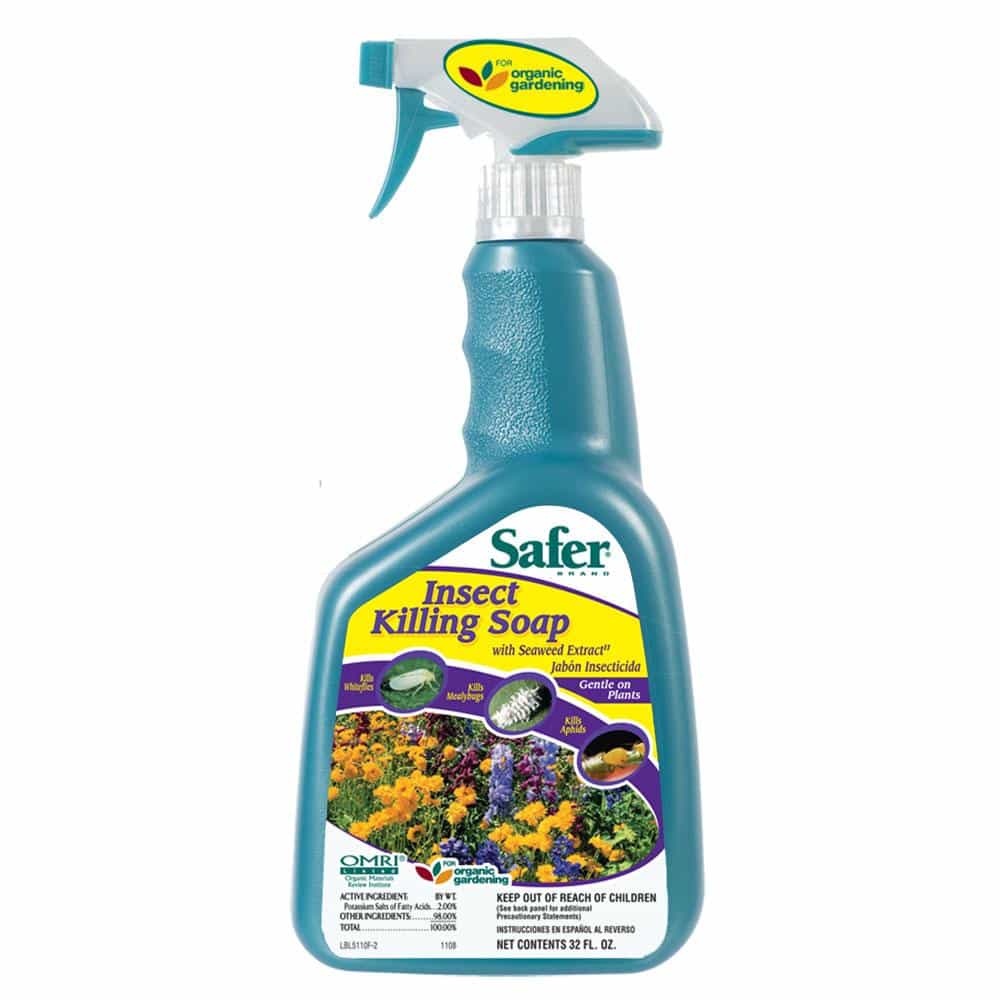
Conscientious marijuana growers are always looking for natural, organic ways to combat pests and avoid using poisonous products on their pot plants. For decades, Safer Soaps have provided many chemical-free ways to control and eliminate insect populations and plant diseases without hurting the environment or your family and pets. So before you resort to going nuclear, try a safer alternative.
5. Just For Coir – Prices Vary
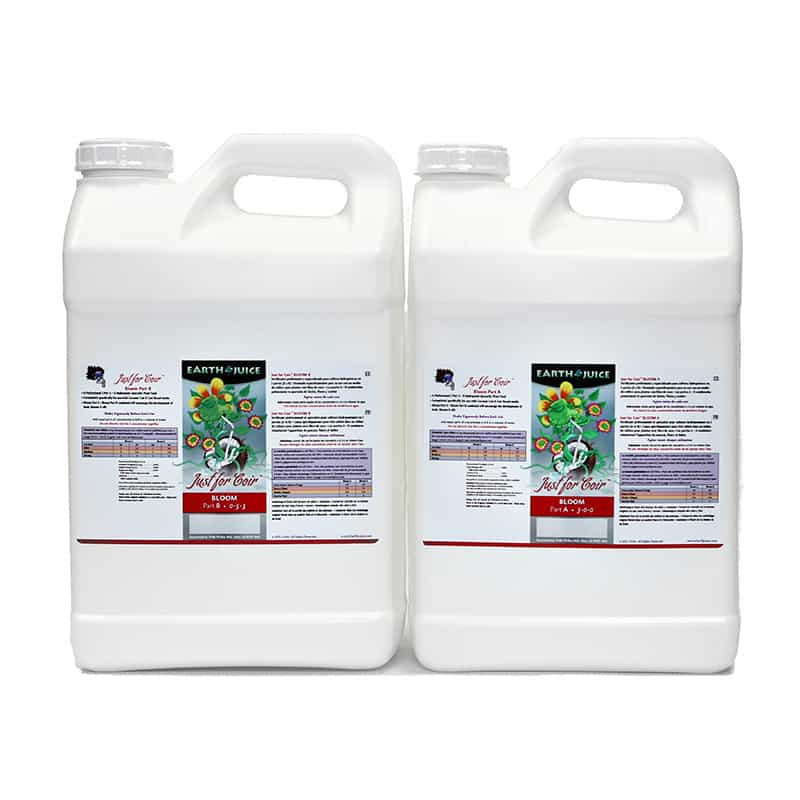
Organic pot growers have long relied on the fine products from Earth Juice. Now, they’ve introduced a new formula specifically for cultivation in coconut coir and coir-based mixes. Their Just For Coir line of nutrients consists of two parts for the vegetative stage and two parts for flowering and promotes vigorous growth and flower production in this popular growing medium.
6. Chikamasa Garden Shears – $29.99
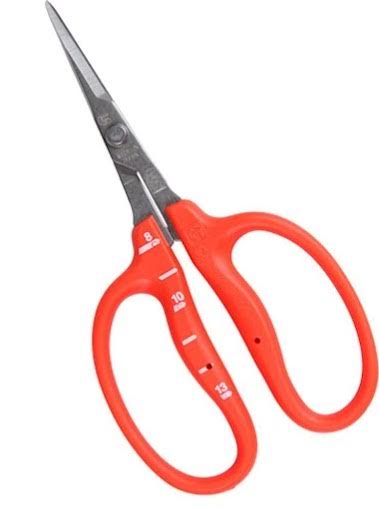
Hand-trimming with improper scissors can lead to slower trim times and hand issues such as carpal tunnel and even crappy-looking leafy buds that don’t taste right. From Japan, land of Bonsai cutting experts, comes these Chikamasa shears that are made from stainless steel and are super sharp and lightweight. They’re ergonomically designed specifically for up-close and detail-oriented trimming that results in properly clipped flowers every time. The slightly curved blade and comfortable handle ensure a timely and accurate trim job.
7. Clean Roots – 15-inch, $8.99; 8-inch, $5.99
 Plants in pots with roots that sit in stagnant salty water quickly begin to deteriorate. The platforms from Clean Roots elevate pots two inches over runoff trays and greatly improve aeration to the root zone—a vital factor in plant health. They’re innovative and affordable as well as made in America. Beware of cheap knockoffs if you want truly clean roots.
Plants in pots with roots that sit in stagnant salty water quickly begin to deteriorate. The platforms from Clean Roots elevate pots two inches over runoff trays and greatly improve aeration to the root zone—a vital factor in plant health. They’re innovative and affordable as well as made in America. Beware of cheap knockoffs if you want truly clean roots.

Clipping leaves from buds can be tedious work. The new TrimBin Filter from the people who brought us the original TrimBin makes this work easier and even sorts the different grades of dry sifted trichome glands that you can later press into your own premium-grade hash. Ergonomically designed to reduce stress on the body and mind, these bins are light, easy to travel with and simple to clean.
9. D.O. Dissolved Oxygen – $57.99 per quart
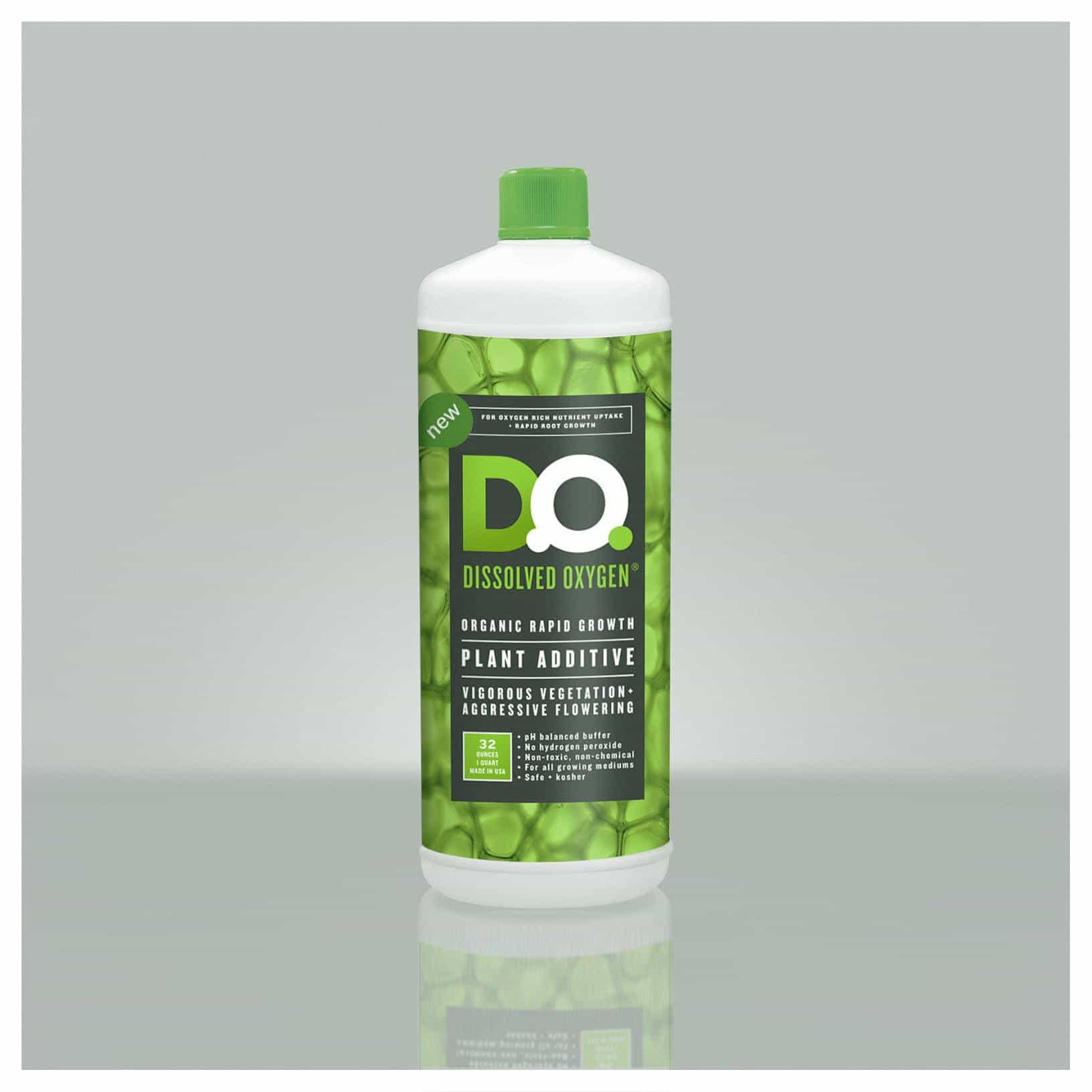
Experienced growers know the value of dissolved oxygen for explosive growth rates. The new first-of-its-kind D.O. Dissolved Oxygen is a concentrated non-peroxide liquid form of oxygen that’s non-toxic, eco-friendly and pet-safe. You can use it as a foliar feed or add directly to your reservoir or nutrient solution soil drench for a huge increase in essential oil production. It even shortens the rooting times of clones!
10. Revolution HPS x Transition from Method Seven – $169.00

With the increasing amount of cheaper plastic grow glasses entering the market, we’re all the more gung ho on the superior products from Method Seven. Their new Revolution HPS x Transition shades provide proper color-balancing indoors under HPS lighting and then change to dark grey-blue outdoors within three minutes in full sun. Comfortable and stylish, these glasses feature a proprietary photochromic lens that allows growers to see the true colors of their plants leaves and protect eyes from bright light.
11. Gas Act – $39.99, Enhancer; $24.99, refill pack
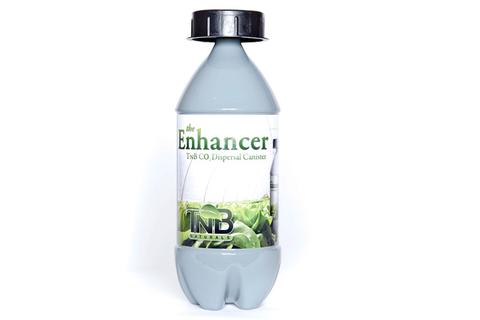
Not all indoor growers can afford CO2 tanks or generators, but they all know that adding carbon dioxide boosts yields substantially. Now even small-scale farmers and micro-growers can organically enlarge their plants with the Enhancer CO2 Dispersal Canisters. All you need to do is add warm water and shake. Handy refill packs ensure that you can re-use these canisters time and time again.
More Holidazeee:
11 Psychedelic Gifts for Your Hippie Friends
11 Great Gifts for Joint Lovers
11 Gifts for Students Stuck Smoking in Their Dorm Rooms
11 Ganja Gifts for Residents of States That Just Legalized
11 Perfect Gifts for Pot-Loving Pet Owners
11 Great Ganja Gifts for Gamers
11 Extravagant Gifts for the Stoner Who Has It All
The High Holiday: How to Toke Safely on the Road
A Stoner’s Guide to Staying High for the Holidays
6 Tips for Being Stoned at Your Family’s Holiday Gathering
Baked Treats for Getting Santa Baked
For all of HIGH TIMES’ grow coverage, click here.
People suffering from post-traumatic stress disorder (PTSD) could soon be prescribed MDMA, commonly referred to as ecstasy or molly, to help ease the debilitating symptoms of this severe anxiety disorder.
A report from the New York Times indicates that the U.S. Food and Drug Administration has approved the drug for clinical trials in an effort to study its effects on patients struggling with PTSD. The latest phase of research, which is being funded by the Multidisciplinary Association of Psychedelic Studies (MAPS), will involve more than 200 patients—mostly veterans, sexual assault victims and others living with the disorder.
Phase 3 clinical trials—the final step before the FDA considers the drug for market—comes after MDMA was shown successful in calming the intensity of PTSD in preliminary studies. If the latest study provides similar results, it is distinctly possible that a wide variety of patients living with this disorder could be using MDMA therapeutically within the next five years.
Some of the patients who were involved in MAPS’ previous studies of the drug say it is more effective than standard therapies.
“One of the first things I said when it kicked in was ‘this is what I’ve been looking for,'” Tony Macie, an Iraqi War veteran, said in a video. “I reconnected with myself and did a lot of internal work, and afterwards, it was like a huge weight was lifted off my shoulders.”
The latest statistics show 83 percent of the participants in the MDMA trials thus far no longer seem to suffer from PTSD after completing two months of treatment. MAPS says the results became more permanent when the patient followed through with a long-term mental health plan, including outpatient check ups with a psychotherapist.
Although it is still too early to tell whether MDMA will land on the shelves of pharmacies all across the nation in the near future, researchers are so far encouraged by their work.
“We can sometimes see this kind of remarkable improvement in traditional psychotherapy, but it can take years, if it happens at all,” researcher Michael Mithoefer told the Times. “We think it works as a catalyst that speeds the natural healing process.”
The latest research is scheduled to begin in 2017, and it is expected to take up to five years to complete. It will then be up to the FDA to determine whether MDMA is safe and effective medicine.
You can keep up with all of HIGH TIMES’ news right here.
Politics The latest in cannabis legalization including laws and policies, legislators’ views, election coverage, and more.

DCMJ, the Washington, DC, advocacy group that led the effort to legalize cannabis in the District, is at it again.
Adam Eidinger, leader of DCMJ, took a group of 17 volunteers to the Capitol Hill office of Sen. Jeff Sessions, President-elect Trump’s nominee for attorney general. There the group met with two Sessions staffers, including communications director Chris Jackson.
Leafly caught up with Adam Eidinger earlier this morning to get his take on the meeting.
“They were aware that we were coming,” Eidinger said, “but they thought we were coming to smoke marijuana in their office. I’m sure they thought they would look perfectly reasonable, but because we didn’t smoke, that somehow made it less newsworthy.”
The group showed up in red T-shirts that bore various slogans based on Sessions’ most famous anti-cannabis quote, “Good people don’t smoke marijuana.” The shirts, emblazoned with bold white letters on a bright red background (in the “Make America Great Again” style), were printed with the words “Great Americans Use Cannabis,” and “Great Americans do not belong in jail for a plant.” Some were more specifically geared towards the groups they represented: “Great Americans know the value of medical cannabis,” and “Great Americans, like veterans, use cannabis.”
“The staff was polite, but they were adamant that no media be allowed in the room,” Eidinger said.
One journalist, Steven Nelson, with US News & World Report, quietly followed the group into the meeting. He remained in the room until the staffers realized who he was and asked him to leave.

Nelson told Leafly he was generally optimistic about the meeting. “It’s hard to say a negative thing about the two Sessions staff members,” he said. “They were respectful, welcoming, and sought to show DCMJ members that they cared about their personal stories and political perspectives.”
As with any political meeting, however, that optimism is tempered by a dose of reality. “As the staff members said themselves, they do not make decisions for Sen. Sessions and I don’t know if marijuana activism will soften his stance,” Nelson said. “Sessions’ comments show consistency and a strong anti-legalization zeal, which is why some groups like DPA [the Drug Policy Alliance] outright oppose his nomination.”
The day after the event, Eidinger expressed disappointment with national marijuana advocacy groups that have expressed dismay with the appointment of Sessions but haven’t yet taken direct action.
“We need to speak up,” Eidinger said. “We are all terrified, and we need to go on the offensive, in fight or flee mode. I just visited Las Vegas for the MJ Biz conference, and it was all businesses and no activists.” He urged those in the industry to speak out, but said he didn’t expect a lot of response.
“They’re just interested in making money, no one is putting their necks out there. These businesses are all disconnected and not taking action. This is not a time to be sitting on the sidelines. One year from now this could all come crashing down.”
Eidinger said DCMJ has further actions in store in the coming weeks and months.
“We haven’t announced it yet, but we’re planning to lawfully distribute 1,000 joints on Inauguration Day. It will all be legal; no person will have more than two ounces of joints to distribute, and we’ll have a list where volunteers can sign up. And we’ll only pass them out to those who are over 21.”
“This might be the last chance we have,” he said. “But we’re gearing up and we’re mobilized and we’re not backing down.”
The post DC Advocates Take Their Case to Jeff Sessions—and He Listens. Sort of. appeared first on Leafly.